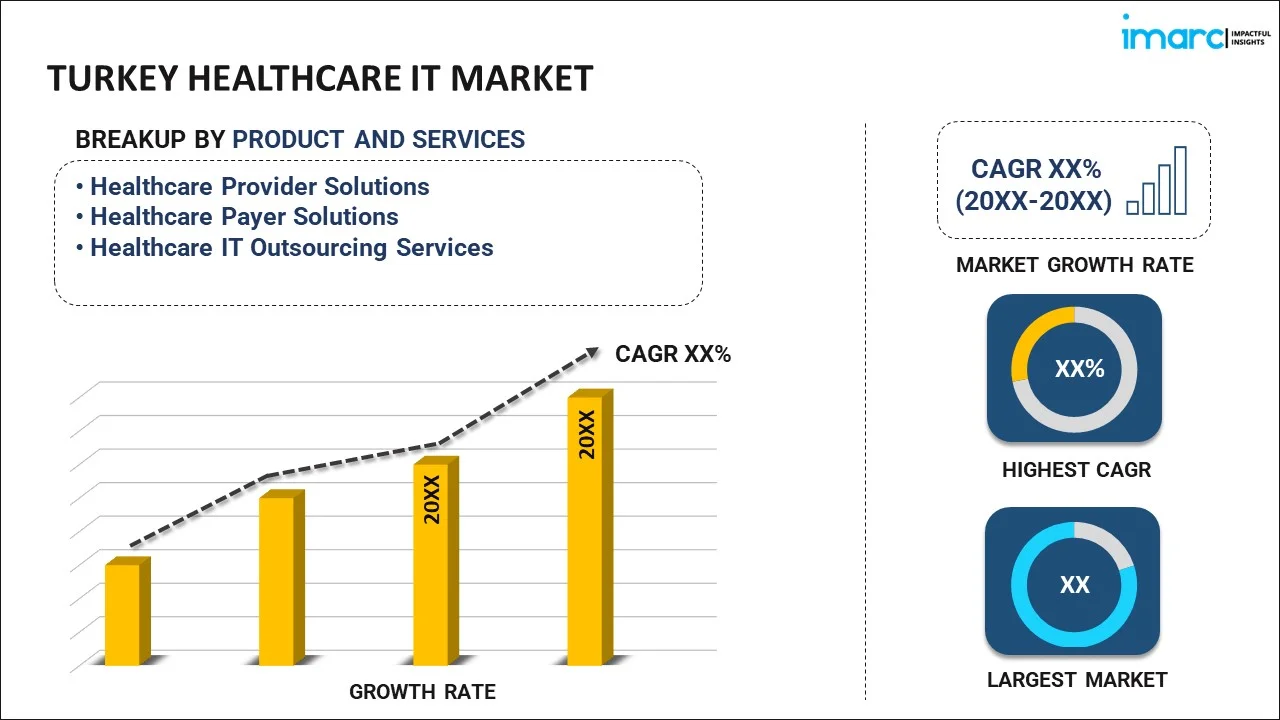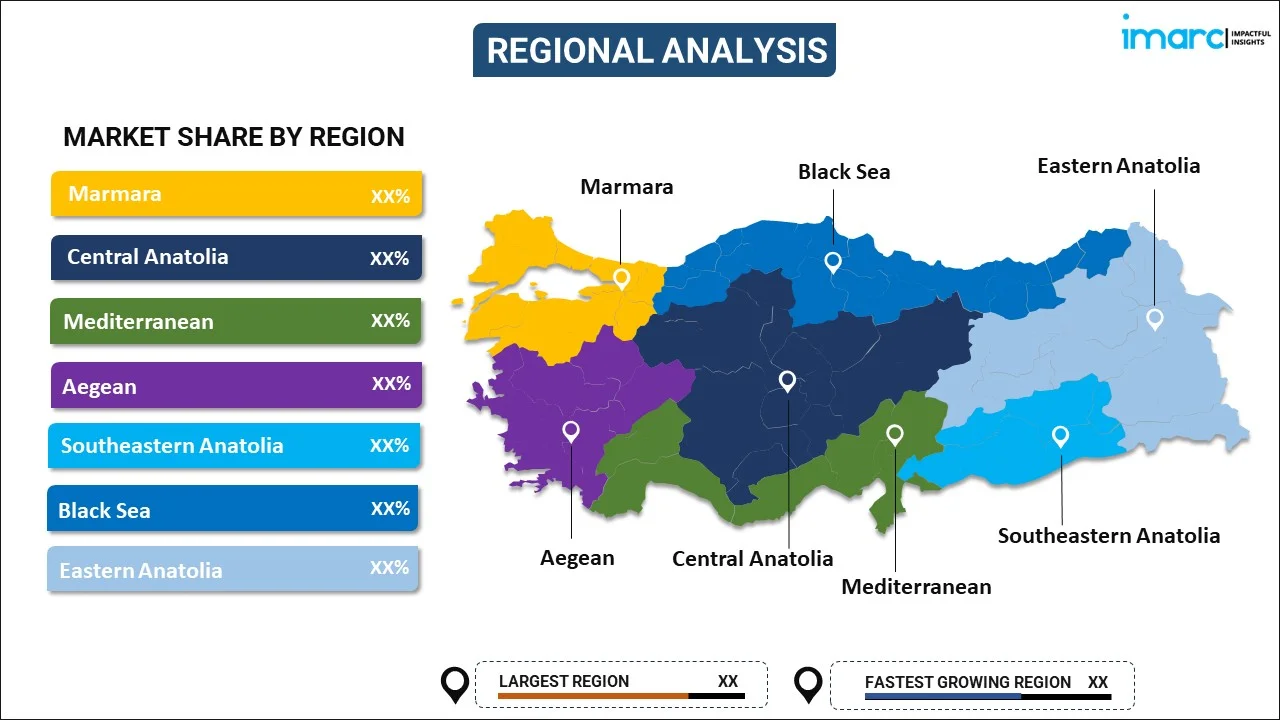
Turkey Healthcare IT Market Report by Product and Services (Healthcare Provider Solutions, Healthcare Payer Solutions, Healthcare IT Outsourcing Services), Component (Software, Hardware, Services), Delivery Mode (On-premises, Cloud-based), End User (Healthcare Providers, Healthcare Payers, and Others), and Region 2024-2032
Turkey Healthcare IT Market Overview:
The Turkey healthcare IT market is projected to exhibit a growth rate (CAGR) of 14.60% during 2024-2032. The market is growing rapidly mainly driven by digital transformation efforts, value-based care models, increased use of wearable and remote monitoring devices and significant investments in cybersecurity. These factors are collectively creating a positive outlook for the market across the country.
|
Report Attribute
|
Key Statistics
|
|---|---|
|
Base Year
|
2023 |
|
Forecast Years
|
2024-2032
|
|
Historical Years
|
2018-2023
|
| Market Growth Rate (2024-2032) | 14.60% |
Turkey Healthcare IT Market Trends:
Digital Transformation and Data Sharing
Digital transformation in Turkey’s healthcare system mainly focuses on integrating data across various providers to enhance patient care. This push toward digitalization aims to overcome existing data silos allowing for the secure and efficient sharing of health information. For instance, in October 2023, Medtronic plc and La Poste partenered to enhance patient care and transform healthcare through digital solutions, data utilization and artificial intelligence (AI). Their innovative platform offers telemonitoring, personalized support and data analysis to improve patient journeys and optimize care. This strategic partnership aims to bring sustainable value to healthcare stakeholders by leveraging cutting-edge technologies and expertise in patient care. By facilitating real-time access to harmonized data healthcare providers nowadays can develop more effective healthcare and disease-prevention strategies leading to improved patient outcomes and overall population health. Investments in modern data platforms, cloud capabilities and data science strategies are essential to support this transformation. Additionally, ensuring common standards and robust cybersecurity measures is critical to protect patient data and foster a data-driven healthcare environment.
Rising Demand for Value-Based Care Model
Value-based care models are revolutionizing healthcare by shifting the focus from the quantity of services provided to the quality of patient outcomes. For instance, in December 2023, the United Nations Institute for Training and Research (UNITAR) and the Global Surgery Foundation (GSF) jointly signed a Vision Statement with the members of the Value-Based Healthcare (VBHC) Expert Working Group in Türkiye. The VBHC Programme's goal in Türkiye is to enhance patient health outcomes by adopting the value-based healthcare approach. Current initiatives focus on identifying and reducing delays in early screening, diagnosis and surgical treatment for breast cancer. The program will continue collecting data in 2024 to guide the development of pilot projects aimed at improving patient outcomes. In this model, healthcare providers are compensated based on the effectiveness of the care they deliver rather than the volume of procedures or visits. This approach aims to enhance patient care quality by encouraging preventive measures, better disease management, and improved patient engagement. It helps reduce overall healthcare costs by minimizing unnecessary treatments and hospital readmissions. Financially, it aligns incentives for all stakeholders—providers, payers, and patients—towards achieving better health outcomes. By fostering a more holistic and coordinated approach to care, value-based care models can lead to significant improvements in patient satisfaction and health system efficiency.
Turkey Healthcare IT Market News:
- In September 2023, UNITAR partnered with the Turkish Ministry of Health and Marmara University School of Medicine and Zonguldak Bülent Ecevit University School of Medicine to collaborate on a Value-Based Healthcare (VBHC) project. The main focus of the project is on breast cancer care in efforts to enhance patient centered care and address the rising rate of non-communicable diseases in Turkey and in the world.
- In March 2024, DoctorCare247 a leading telehealth company partnered with the Turkish Healthcare Travel Council (THTC) to provide Nigerians with enhanced access to advanced medical care in Turkey. The collaboration aims to offer top-notch healthcare services including fertility treatment, cosmetic surgery and cardiology to Nigerian patients. This strategic partnership aligns with efforts to promote Turkey as a premier destination for superior healthcare and is expected to bring about exceptional healthcare delivery options for patients in Nigeria.
Turkey Healthcare IT Market Segmentation:
IMARC Group provides an analysis of the key trends in each segment of the market, along with forecasts at the country level for 2024-2032. Our report has categorized the market based on product and services, component, delivery mode and end user.
Product and Services Insights:

- Healthcare Provider Solutions
- Clinical Solutions
- Nonclinical Healthcare IT Solutions
- Healthcare Payer Solutions
- Pharmacy Audit and Analysis Systems
- Claims Management Solutions
- Analytics and Fraud Management Solutions
- Member Eligibility Management Solutions
- Provider Network Management Solutions
- Billing and Accounts (Payment) Management Solutions
- Customer Relationship Management Solutions
- Population Health Management Solutions
- Others
- Healthcare IT Outsourcing Services
- Provider HCIT Outsourcing Services Market
- Payer IT Outsourcing Services
- Operational IT Outsourcing Services
The report has provided a detailed breakup and analysis of the market based on the product and services. This includes healthcare provider solutions (clinical solutions and nonclinical healthcare IT solutions), healthcare payer solutions (pharmacy audit and analysis systems, claims management solutions, analytics and fraud management solutions, member eligibility management solutions, provider network management solutions, billing and accounts (payment) management solutions, customer relationship management solutions, population health management solutions, and others), healthcare IT outsourcing services (provider HCIT outsourcing services market, payer IT outsourcing services, and operational IT outsourcing services).
Component Insights:
- Software
- Hardware
- Services
A detailed breakup and analysis of the market based on the component have also been provided in the report. This includes software, hardware, and services.
Delivery Mode Insights:
- On-premises
- Cloud-based
The report has provided a detailed breakup and analysis of the market based on the delivery mode. This includes on-premises and cloud-based.
End User Insights:
- Healthcare Providers
- Hospitals
- Ambulatory Care Centers
- Home Healthcare Agencies, Nursing Homes, and Assisted Living Facilities
- Diagnostic and Imaging Centers
- Pharmacies
- Healthcare Payers
- Private Payers
- Public Payers
- Others
A detailed breakup and analysis of the market based on the end user have also been provided in the report. This includes healthcare providers (hospitals, ambulatory care centers, home healthcare agencies, nursing homes, assisted living facilities, diagnostic and imaging centers, and pharmacies), healthcare payers (private payers, public payers), and others.
Region Insights:

- Marmara
- Central Anatolia
- Mediterranean
- Aegean
- Southeastern Anatolia
- Blacksea
- Eastern Anatolia
The report has also provided a comprehensive analysis of all the major regional markets, which include Marmara, Central Anatolia, Mediterranean, Aegean, Southeastern Anatolia, Blacksea, and Eastern Anatolia.
Competitive Landscape:
The market research report has also provided a comprehensive analysis of the competitive landscape. Competitive analysis such as market structure, key player positioning, top winning strategies, competitive dashboard, and company evaluation quadrant has been covered in the report. Also, detailed profiles of all major companies have been provided.
Turkey Healthcare IT Market Report Coverage:
| Report Features | Details |
|---|---|
| Base Year of the Analysis | 2023 |
| Historical Period | 2018-2023 |
| Forecast Period | 2024-2032 |
| Units | Billion US$ |
| Scope of the Report | Exploration of Historical and Forecast Trends, Industry Catalysts and Challenges, Segment-Wise Historical and Predictive Market Assessment:
|
| Product and Services Covered |
|
| Components Covered | Software, Hardware, Services |
| Delivery Modes Covered | On-premises, Cloud-based |
| End Users Covered |
|
| Regions Covered | Marmara, Central Anatolia, Mediterranean, Aegean, Southeastern Anatolia, Blacksea, Eastern Anatolia |
| Customization Scope | 10% Free Customization |
| Post-Sale Analyst Support | 10-12 Weeks |
| Delivery Format | PDF and Excel through Email (We can also provide the editable version of the report in PPT/Word format on special request) |
Key Questions Answered in This Report:
- How has the Turkey healthcare IT market performed so far and how will it perform in the coming years?
- What has been the impact of COVID-19 on the Turkey healthcare IT market?
- What is the breakup of the Turkey healthcare IT market on the basis of product and services?
- What is the breakup of the Turkey healthcare IT market on the basis of component?
- What is the breakup of the Turkey healthcare IT market on the basis of delivery mode?
- What is the breakup of the Turkey healthcare IT market on the basis of end user?
- What are the various stages in the value chain of the Turkey healthcare IT market?
- What are the key driving factors and challenges in the Turkey healthcare IT?
- What is the structure of the Turkey healthcare IT market and who are the key players?
- What is the degree of competition in the Turkey healthcare IT market?
Key Benefits for Stakeholders:
- IMARC’s industry report offers a comprehensive quantitative analysis of various market segments, historical and current market trends, market forecasts, and dynamics of the Turkey healthcare IT market from 2018-2032.
- The research report provides the latest information on the market drivers, challenges, and opportunities in the Turkey healthcare IT market.
- Porter's five forces analysis assist stakeholders in assessing the impact of new entrants, competitive rivalry, supplier power, buyer power, and the threat of substitution. It helps stakeholders to analyze the level of competition within the Turkey healthcare IT industry and its attractiveness.
- Competitive landscape allows stakeholders to understand their competitive environment and provides an insight into the current positions of key players in the market.
Need more help?
- Speak to our experienced analysts for insights on the current market scenarios.
- Include additional segments and countries to customize the report as per your requirement.
- Gain an unparalleled competitive advantage in your domain by understanding how to utilize the report and positively impacting your operations and revenue.
- For further assistance, please connect with our analysts.
 Inquire Before Buying
Inquire Before Buying
 Speak to an Analyst
Speak to an Analyst
 Request Brochure
Request Brochure
 Request Customization
Request Customization




.webp)




.webp)












